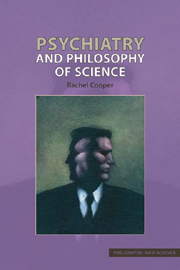Book contents
- Frontmatter
- Contents
- Acknowledgements
- 1 Introduction: psychiatry and philosophy of science
- 2 The nature of mental illness 1: is mental illness a myth?
- 3 The nature of mental illness 2: if mental disorders exist, what are they?
- 4 Explanations in psychiatry 1: natural-history based explanations
- 5 Explanations in psychiatry 2: individual case histories
- 6 Relations between theories 1: when paradigms meet
- 7 Relations between theories 2: reductionisms
- 8 Managing values and interests 1: psychiatry as a value-laden science
- 9 Managing values and interests 2: big business and judging treatments
- 10 Conclusion
- Notes
- Further reading
- Bibliography
- Index
3 - The nature of mental illness 2: if mental disorders exist, what are they?
- Frontmatter
- Contents
- Acknowledgements
- 1 Introduction: psychiatry and philosophy of science
- 2 The nature of mental illness 1: is mental illness a myth?
- 3 The nature of mental illness 2: if mental disorders exist, what are they?
- 4 Explanations in psychiatry 1: natural-history based explanations
- 5 Explanations in psychiatry 2: individual case histories
- 6 Relations between theories 1: when paradigms meet
- 7 Relations between theories 2: reductionisms
- 8 Managing values and interests 1: psychiatry as a value-laden science
- 9 Managing values and interests 2: big business and judging treatments
- 10 Conclusion
- Notes
- Further reading
- Bibliography
- Index
Summary
This chapter examines in greater detail the nature of mental disorder. I address two questions: what is the distinction between mental and physical disorders, and what makes something a disorder at all, as opposed to a normal variation or a moral failing, for example?
The distinction between physical and mental disorders
The first question we must consider is whether mental and bodily disorders should be considered together, or whether they are radically dif erent kinds of condition. As we have seen, some theorists, such as Szsaz, hold that mental and physical disorders are radically distinct (on Szsaz's account, physical disorders are caused by lesions, whereas mental disorders are mere myths). Still, most contemporary accounts of disorder seek to accommodate both mental and bodily disorders together. In this section I shall argue that this is the most reasonable approach to take.
Attempts to draw a clear-cut distinction between physical and mental disorders fall into difficulties. Splitting disorders on the basis of whether they have physical or psychological causes will not work, as many disorders are affected by both psychological and physical causal factors: one's risk of developing schizophrenia is increased by social stressors, and also by drug abuse, birth complications and genetic factors. Many disorders that are generally considered to have physical causes are made worse by stress, for example, allergies and high blood pressure.
- Type
- Chapter
- Information
- Psychiatry and Philosophy of Science , pp. 28 - 43Publisher: Acumen PublishingPrint publication year: 2007



